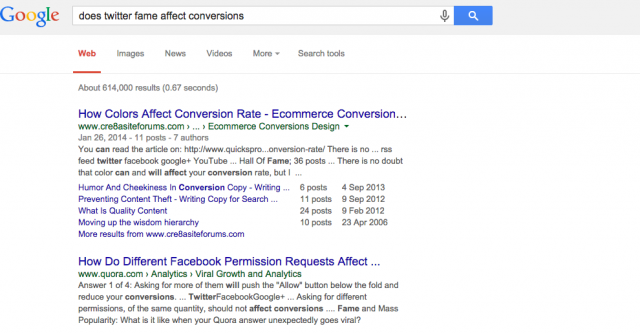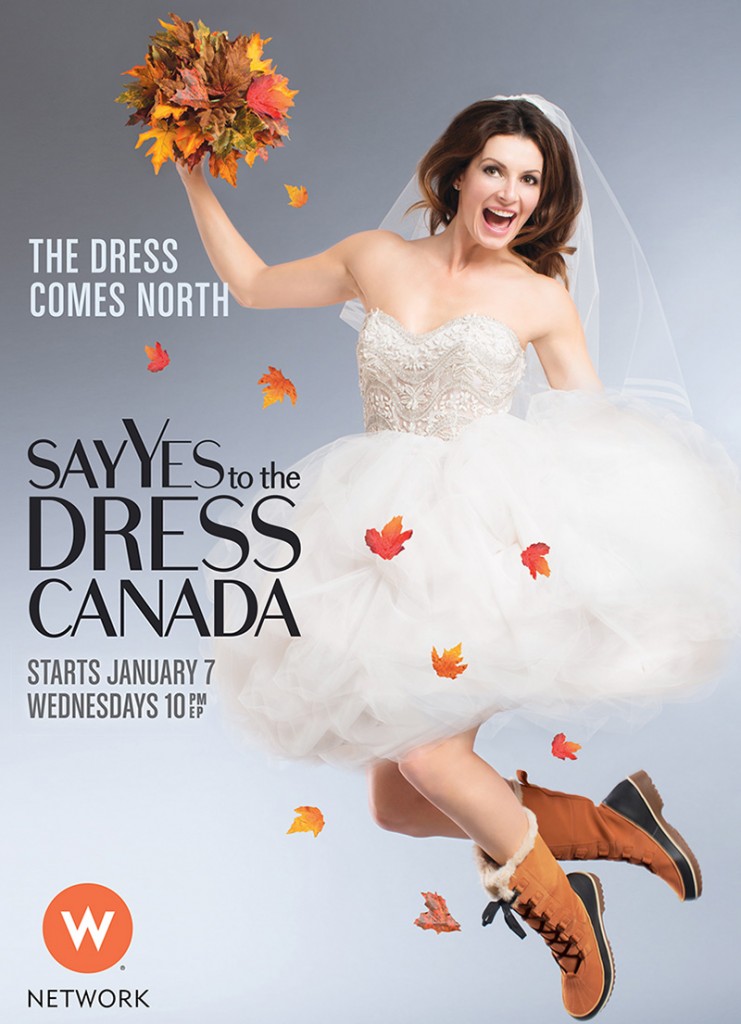
It all started when that friend of yours, Oreo is his name? We all remember a tweet he put out during a certain “big game” a few years back and we’re worried you’re spending too much time in his shadow. And don’t get us started on that DiGiorno kid, snarkily live-tweeting things that he has no business watching, and charging blindly into hashtags with no context. You’re running with a bad crowd. If Oreo jumped off a bridge with a Go-Pro strapped to his head, would you do it too? Okay, admittedly that sounds pretty cool – but trust us, don’t do it.
It seems like we’ve (read: Erin) written a ton of articles about real-time marketing and you know what? I’m just going to put the final nail in the coffin right now and declare it a dead trend. It had a good run but now it’s just getting…obnoxious.
As part of a digital strategy, being nimble enough to react to trends is one thing. That is, until using social to “disrupt the conversation” results in a strange tendency to be on top of EVERYTHING, regardless of relevance to your brand to try to be snarky or funny. It’s weird, like being in a crowded bar and having 70 stand-up comedians try and get your attention all at once. A well-executed tweet here and there will create a positive sentiment, but there are no facts to back up the notion that real-time marketing (RTM) has an effect on conversions. I even did some hard-hitting journalistic research to back up my hypothesis:
Nope, nothing.
Instead of gaining recognition for being clever or entertaining, brands that engage in RTM more often than not become the butt of the joke, like John St.’s tongue-in-cheek video making fun of ”reactvertising,” and brands’ need to be on top of The entire Internet in the event of a branding opportunity. In the end brands only look desperate for attention. Some of them end up in hot water for maybe not having the best grasp of “context.” A gimmick that was once funny and a little bit ironic now feels like beating a dead horse, and has resulted in contempt and scorn from marketers and consumers alike. When things go wrong it’s instant schadenfreude, even from those of us who work in the same space.
This isn’t to say that we should stop entirely trying to insert our brands into the zeitgeist (shudders), but we could be much more discerning and cautious when it comes to social listening and brand fit. If we – brands, marketers, agencies – can stop acting like the loud, obnoxious fat guy at the party, we could go back to being someone with a compelling story that people actually want to talk to.
Jason is a Digital Strategist at 88 Creative. Follow him on Twitter @Jasegiles.
]]>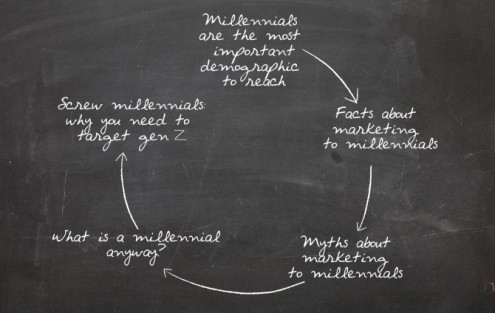
Clickbait like 3 Marketing Myths That Make Millennials Hate Your Brand has become de rigueur on the marketing blog circuit. It’s a cycle of promises that looks something like this: 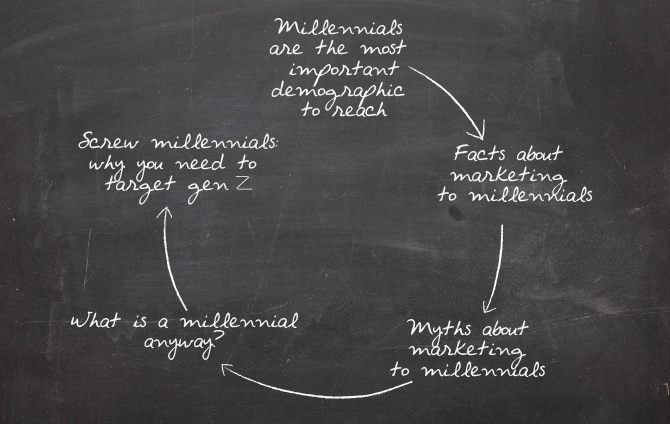 While every marketer and advertiser has to know who they’re speaking to, the problem with drawing conclusions about whole generations is that you’re aiming at a moving target; people change, society shifts, and individuals move from group to group (as millennials grow up and/or become parents, for example). There’s also the danger of misreading evidence and confusing cause and effect.
While every marketer and advertiser has to know who they’re speaking to, the problem with drawing conclusions about whole generations is that you’re aiming at a moving target; people change, society shifts, and individuals move from group to group (as millennials grow up and/or become parents, for example). There’s also the danger of misreading evidence and confusing cause and effect.
For example, one thing I read all the time is that millennials are narcissistic. The evidence seems to be that they post a lot of selfies. But would baby boomers have posted selfies if it had been an option? This is the generation behind the sexual revolution – they were changing the world and they knew it. I’m pretty sure there would have been a few mud-soaked topless selfies taken at Woodstock.
The other common mistake is to take a very common trait, like being price-conscious, and decide that it defines a generation. Almost everyone is price-conscious to a degree (even if they buy high-end, luxury items), but that’s not synonymous with spending as little as possible. This was one of the myths featured in the Inc. article mentioned above. A better way of putting it is value-conscious; people of all generations are willing to spend money on things that matter to them. But hasn’t that always been true, at every price level and in every economy?
There’s also the most obvious problem of trying to figure out who actually belongs to a target audience (I was born right at the beginning of the millennial generation and I often feel quite different from those crazy Snapchatting kids). So what’s the answer? I think it starts with what you’re selling. What are you really offering people? Everyone ultimately cares about what’s in it for them. If you’re making something cheap to appeal to millennials because you think that’s their main concern, you haven’t given them what they’re looking for. If the product offering isn’t up to par in terms of quality, design, or functionality, you’re not giving them value.
While media choices are a great way to find your target audience (hint: moms of young kids are all on Facebook) when you craft your messaging around assumptions about a large group, you could be getting it wrong. Start with how your product makes people’s lives better (easier, more beautiful, more fun) and they will find you.
]]>
Warning: this blog post is a rant. If you’re having a great day and see the world through rose-coloured glasses, please DO not read. If you’re like me and cynical as they come, then proceed.
Last year when I was hanging out with my teenaged family members, I remember one of them saying “Do it for the Vine!” When I asked them about it, they proceeded to tell me how people do crazy, sometimes stupid stuff, just so they can get a 6-second Vine out of it, with hopes of it going viral.
… What?!
I was a little flabbergasted – and kind of unimpressed. I like to think that these viral videos we see of kids saying the darndest things or flash proposals are purely for the sake of those involved and completely candid. Newsflash: they’re not.
The internet has totally made me a cynical person and after a few popular videos turned out to be staged, I’ve started to doubt everything. Nothing is at it seems. The world is NOT round – okay, it is. But you get what I mean.
It irks me that people are making these videos and almost exploiting their happy moments. Remember that dude who proposed to his girlfriend in a photo booth? Why did he have to record that? Or wait, let him record it but why did he have to share it with the whole world? I don’t care what people say – it does not restore my faith in humanity to see people doing cute things if they’re doing it for fame.
Same goes for the lady who told her husband that she was pregnant (again, in a photo booth – how unoriginal) and recorded it. Did she for a second think that maybe this moment didn’t need to be shared with the world? To treasure it as a special moment between just her and her SO? Maybe share it with their kids and close family members later? Nope – it’s on the Internet for the world to see.
I’m just totally unimpressed with people of the internet lately, and yes that includes you Maroon 5. Your Sugar video is just that: sweet, but we all know it’s staged. A for effort in pretending it’s not, but the truth has come out and you should’ve just skipped the beginning where you pretend it’s just some impromptu wedding crashing adventure.
Do I do cute things? All the damn time! Does my husband record me? Very seldomly. And even if he does, he doesn’t upload it onto YouTube with hopes of me being the star of the next Acura commercial.
Is it really too much to ask for to watch something on the Internet that hasn’t been done for the sole purpose of going viral? Live your life for you, not for 15 minutes of Internet fame.
]]>
Until, of course, it started happening here. With the influx of American retailers and media, it seems more often than ever campaigns are swapping apple pie for maple donuts, and expecting to elicit a feeling of Canadian pride so strong that I’ll actually drop my Loonies on their product. This token patriotism, the laziest form of human truth, makes me both depressed and irritated.
A misconception advertisers struggle with is the formulaic application of American techniques to Canadian audiences. While Americans are quite patriotic, it’s a well-documented phenomenon that Canadians don’t feel the same sense of Canadianism, or a love of Canadiana. You cannot swap Uncle Sam for a Mountie and expect us to relate to it. We’re a nation of immigrants, a nation made of the traditions of other nations, a place where poutine is topped with butter chicken and about 1% of the population has spent time in an igloo – why is it expected that we’ll swallow the maple syrup the same way the States scarfed down Freedom Fries?
One recent example is a campaign out right now for Say Yes To The Dress Canada that features only a bride wearing snowboots and carrying a bouquet of maple leaves. There’s no action, plot, or story – there’s only this inexplicably jacketless woman. It was only after getting past the fact that snow boots and maple leaves don’t even exist in the same season – also, isn’t she cold? – that I got around to annoyance over this ham-fisted pandering. I’m all for CanCon, but come on! Who do these people think they are? Moreover, who do they think I am?
It’s not only Canadian conversions of American campaigns that are guilty of this. As Tim Hortons loses market share to Starbucks and McCafe, the so-called Coffee Wars have brought out a particularly plastic iteration of our favourite Canadian tropes. Take Starbucks’ social campaign to name the blond coffee blend that’s particularly popular here. Thousands of entries, and what do they pick? True North. TRUE NORTH. If trying to get Canadians, in 2013, to stake patriotic ownership in something as insignificant as a blend of coffee forces us to default to a line from the national anthem, we’re doing something wrong. Is True North selling? Sure, but did Starbucks summon the same emotional attachment and quasi-pride we feel toward Timmies? I think not.
So, my hope – note, not my prediction – for 2015 is that we can make a brand of patriotism that’s true. Why can’t we talk about being a nation that celebrates politeness, instead of relegating it to satire? Why can we only talk about our abundant natural beauty in Molson commercials? Why do we continue to jam Mounties in places they have no business being, despite the fact that they’ve been embroiled in scandal for years, and, despite the fact that I’ve lived in Canada my entire life, I’ve never seen one? Why do we create cyclical media messaging that just ticks box after box on a list of cliches ending in a woman literally using maple leaves as a bouquet on her wedding day?
That is still a really excellent ad.
Let’s start a conversation we can relate to. Let’s start a dialogue that celebrates real, solid and true reasons why being a Canadian is a privilege. Let’s start talking about why we’re really proud to be Canadian. I might love sneering at the States’ ads, but I hate to sneer at ours.
]]>
Everyone will hashtag their first name in Tweets, turning Twitter into HARD TWITTER. Once it gets too easy to compile your thoughts into 140 characters, Twitter users will be looking for a challenge. Add your name as a hashtag and BOOM! Just like that you’re dealing with 134 characters. Or, start referring to yourself in the third person. I promise, you’ll be a trend-setter in no time.
Instagram, tiring of consistent visual content, will start exploring font treatments and adding fonts to our perfectly- filtered photos.Do you know what’s kind of getting old. Pictures of food. And realistically, who even reads the captions. What we want is CONTENT ABOVE THE FOLD.
Someone creates Smellstagram and the results will be exactly what you think they would be. #farts
BIG DATA becomes HUMONGOUS DATA As people want to go more macro to gain insights about the wider society that their customers live in. I have no idea what this means. Just call a sociologist at this point.
The US Government will impose sanctions on BuzzFeed for making quizzes. JUST STOP ALREADY I KNOW HOW BASIC AND 90’S I AM.
SnapChat will finally get real and accept advertising money from the likes of Durex and Trojan because lets call a spade a spade – It’s a sexting app.
That one’s free, advertisers. Feel free to run with that idea.
Vine will become overloaded with “Bruh” vines and “My name is Jeff” that it will become all but obsolete in 2015
Someone will create a “Facebook, but for like marketers and advertisers” that is pay to play. It will be hugely successful as brands compete for advertising professionals, journalists, bloggers and other brands’ attentions for collaboration and synergistic opportunities. Think of it as a mix of Dragon’s Den and Real Housewives of New Jersey. It’s basically the antithesis to Ello and probably slightly less douchey.
Facebook will be overrun with grandparents.
Think about it, the demographic with the biggest growth on Facebook is easily 40+. Now that all of the cool teens are staying away from Facebook, it’s only a foregone conclusion that our parents will all overpower us with Candy Crush requests, retirement vacation property pictures, not-so-subtle reminders that you’re almost 30 and not married yet and posts that have tagged grandmaster flash in them.
Ello will experience a huge user base influx and rival Facebook.
Just kidding, this one is a joke.
]]>
As marketers, we’ve all done it. We’ve thrown the “social conversion” idea out there to our clients. OOOH sparkly. What is a social conversion? It’s the purest form of the social sales funnel – someone likes a promoted page, interacts with their content, and makes a purchase decision either in-store or through an e-commerce site.
Facebook ads are an incredibly cost-effective marketing tactic and they do work. I’ve just never had any anecdotal proof from someone I know in person, which always kept me a little skeptical as to who was converting to a brick-and-mortar customer?
Like a unicorn, a social conversion is often talked about yet rarely if at all documented. I mean, sure if you’ve got a tracking pixel installed for your Google AdWords/Facebook ads campaigns you can SEE them. But they are like a mythical creature, the stories of which were told by employees who could have sworn someone said “Oh, I found you on Facebook” to them.
Until it happened to me. I became one.
There is a very small, independent hockey equipment store around the corner from my house. I’ve been seeing their ‘like’ ads constantly on Facebook since the beginning of the year. As someone who usually ignores ads like it’s a goddamn Olympic sport I was intrigued because
A) they seemed to legitimately care about hockey and hockey equipment and
B) It’s right around the corner from my house and could come in handy if I needed a quick sharpening.
So I liked the page. Excellent job, ad targeting guy.
The content on their page was focused mostly around lifestyle posts and sales. You know, “DANGLE SNIPE WHEEL CELLY” typical stuff. But what did strike me as intriguing was their knowledge of skate sharpening. Instead of being just a thing that they offer like some major big box stores, they had a ton of knowledge about how to sharpen skates based on people’s weight and the position they play.
Not to bore you with the finer points about skate sharpening, but while pro hockey players get it done in between periods, weekend warriors such as myself can get away with a sharpening every 3 games or so. So not only is a good sharpening supposed to last you a while, having a sharp blade is key when you’re trying to torch past Steve from accounting on your way to scoring your second goal of the night (guys I play with know this never happens).
Fast-forward a couple months and I needed a sharpening before a game. After years of taking my skates to pro shops and getting them sharpened by part-time employees who were trying to avoid working the sales floor, I decided to finally give this place a shot. I was amazed to find a place that not only knows what it means when I ask for a ⅜ hollow, but went the extra step in fixing a warping issue that happened to the blades in a previous sharpening by aforementioned part-time big-box employee.
After becoming a socal-to-in-store conversion, I’m going to recommend their services to my family, friends, and my team. That’s called being a brand advocate and is the ultimate goal of advertising on Facebook.
Yes, I am a social conversion and I’m alright with that.
]]>
I have a love-hate relationship with Instagram. Of course I love going through the hundreds of thousands of pictures of celebrities, shoes, cupcakes and hedgehogs, but I also hate it because people seem to have way cooler experiences and better clothes than me.
I also don’t get how I never get more than 100 likes on any given picture. I have almost 1,000 followers on Instagram so shouldn’t at least half those people like my pictures? Why follow me if you’re not going to like my picture of me jumping in a pile of leaves wearing the cutest cardigan, drinking a Pumpkin Spice Latte (I may or may not be basic, don’t judge me).
It makes zero sense. I get that 1/10th of those people probably downloaded the app, followed everyone on their contact list and then forgot about it. But 900 of my followers use Instagram regularly and are seeing my pictures, right? And that goes for anyone really – some girls have thousands of followers but only get a few hundred likes.
So why do people follow you if they don’t like your pictures? This question recently came up at a cottage retreat when I asked a fellow co-worker why he didn’t like my picture of cereal-flavoured ice cream. He promptly said it’s because he doesn’t like ice cream.
Good enough reason I guess, but I’m a firm believer in loyalty liking – if you like the person, like their damn pictures!
Anyway, because of this, I’ve determined there are several different types of Instagram followers and their behaviour explains the likes, or lack thereof:
Loyalty Likers: these people are usually your closest friends, significant others, siblings and grandmother. They will (read: better) like all your pictures regardless of what you post because they are loyal to you. Ride or die, and all o’ that.
The Real Deal: these people like what they like, and don’t pay attention to the person who posted it. Everyone claims to fall under this category, but let’s be serious – very few people actually like what they like, regardless of who posted it. But if you do – kudos. You’re the real MVP.
Fake Friends/Family: these people are often related to you or are friends by association. They don’t really like you, yet they follow you and like all your pictures because they pretend to like you. They’ll never comment on your pictures because let’s be real, anyone can double-tap but coming up with a compliment for someone you don’t like? That takes real guts (and time).
The Celebrity Stalker: these folks pretty much only follow celebrities and try to be the first like/dole out advice to said celebrity. Let’s get one thing straight – Kim Kardashian is NOT going to notice you were the first like on her picture and then become your BFF. Also, following celebrities will probably only make you feel super inadequate about your own life.
The Jerk: we all know someone like this. In fact, it might even be you. You follow someone on Instagram because you’re socially obligated to (it could be your cousin’s girlfriend or your best friend’s new boyfriend that you just can’t stand). Basically, you follow them on Instagram but you hate their guts, and thus refuse to like anything they post. But you see it, and you notice. You just choose not to give them that like.
The Scroller: scroll, double tap, scroll, double tap. These Instagram users just go through their feed in a daze, not paying attention to what they’re liking. This is usually all of us at 6 AM when we’re just waking up.
The 99%: In the world of the Internet, there is a rule that only 1% of the users on any given website actively create content, while 99% of these users just use the platform to creep. Don’t be one of those people, just don’t.
The Late Liker: There are people who rarely open their Instagram app and then when they do, it’s a liking spree! We all know someone who does this and it’s crazy annoying. But then there’s also the, in air quotes, “Late Liker” who pretends to be too busy to go on Instagram but is really on it 24/7.
So which liker are you?
Hafsa is a Digital Marketing Coordinator at 88 Creative. You can follow her Tweets at @Hafs__.
]]> Christopher Nolan wrote an op-ed in the New York Times last week lamenting the state of modern filmmaking in Hollywood. In making his point, he lumped in filmmaking and the business of major motion pictures under the rather general content creation umbrella.
Christopher Nolan wrote an op-ed in the New York Times last week lamenting the state of modern filmmaking in Hollywood. In making his point, he lumped in filmmaking and the business of major motion pictures under the rather general content creation umbrella.
Personally, in some weird way, I feel honoured to have what I do placed in the same realm as putting out an entire freaking motion picture. But allow me to put on my film student beret and scarf for a second here. The crux of his argument is that the process of filmmaking - the physical act of creating a film and having it projected -is dying off in favour of a digitized model that doesn’t necessarily need to be shown in a theatre. This worries him as an artist.
Nolan argues that the theatre is not what it once was. The theatre is now merely one other place that this piece of content can be displayed rather than the final destination for the product. This, he fears, will ruin the experience of watching a film.
If you can download a blockbuster movie on your phone and watch it on your way to work in the morning, does it have the same impact as watching it in a theatre environment? Will the plot, or erm, the content still be the same?
Forgive me, Mr. Nolan, but in regards to what we do as digital content creators, does looking at an Instagram photo on Facebook take away from the experience? Cross-pollenation of content is the lifeblood of our business; get on as many screens as possible and hope that there are a ton of eyeballs watching at the right time. Oh, and make good things that people want to watch, read, or engage with. That helps too.
For an artist, I can understand this rather crippling notion that the work you do becomes void of meaning when it’s mass-produced, but production doesn’t always equal consumption (see Thicke, Robin – Paula, 2014). If something is really well done, the message will get across regardless of whether or not the way the audiences consumes it aligns with the creator’s vision of what the “experience” should be.
Jason is a Digital Strategist at 88 Creative. Follow him on Twitter @Jasegiles.
]]>
As a digital marketer, I see a lot of Tweets. I manage 10 accounts, each account following 1,000+ users on Twitter. On top of that, I have keywords, alerts and lists set up to make sure that I don’t miss a beat. Yes, that’s thousands of Tweets a day. Many of them are interesting, funny, useful and visually pleasing. Some of them are just useless.
My personal philosophy is if you don’t have anything interesting to say, don’t say it. That may sound harsh, but seriously. I mean it. If you’re going to take to Twitter to post a generic message to nobody, you should just skip it. What I’m talking about is the kind of Tweets we’ve all seen before: “Good morning, world! How was your sleep?” or “Happy Monday! Hope you all have a great week!” or my personal favourite, “Hello! How’s your end of the Interwebs?” Do you have no imagination at all? Are you so void of interesting content that your only option is to ask a generic question to nobody? And be honest, how many times have these Tweets garnered amazing interaction and conversation? My guess is 0, zilch, none. Correct me if I’m wrong though.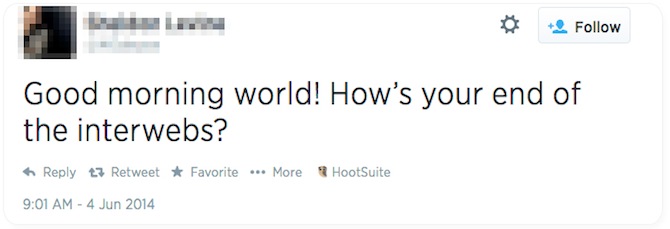

 As I mentioned before, I do believe that Twitter is meant to be an interactive and social network. I believe in interesting and meaningful conversation with strangers from all over the Twitterverse. That’s the beauty of the network! But the bottom line is that no one is forcing your hand to a keyboard to send out Tweets – we aren’t Twitter monkeys here, so if you don’t have anything important to say, drop the smartphone and back away until your clever brain thinks of something great. It’s bound to happen at some point, right?
As I mentioned before, I do believe that Twitter is meant to be an interactive and social network. I believe in interesting and meaningful conversation with strangers from all over the Twitterverse. That’s the beauty of the network! But the bottom line is that no one is forcing your hand to a keyboard to send out Tweets – we aren’t Twitter monkeys here, so if you don’t have anything important to say, drop the smartphone and back away until your clever brain thinks of something great. It’s bound to happen at some point, right?
Are you a useless Tweet offender? Defend yourself! Find me on Twitter at @DFabes, or make your case in the comments.
]]>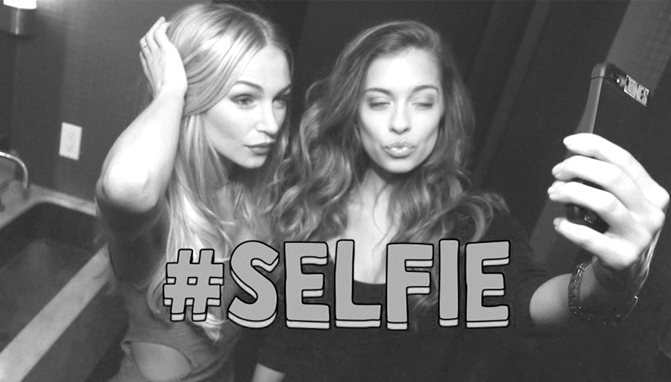
Ahh, the selfie. There’s a song about it, it was recently added to the dictionary, and it’s totally taken over my Instagram newsfeed.
Oh, and it’s also been linked to narcissism, mental illness and addiction.
For reals. The International Business Times recently reported that “the growing trend of taking smartphone selfies is linked to mental health conditions that focus on a person’s obsession with looks.”
And obsessed is exactly the right word for it. People are obsessed with looking at other people’s pictures, seeing that they might be getting more attention, and without really intending to they end up comparing themselves and focusing on their looks.
We all have friends who post selfies of themselves, week after week. The same pose, the same makeup, the same bedroom … it’s pretty much the same picture with a different Instagram filter and a different totally irrelevant song lyric or famous quote as a caption.
Is it because our generation has become consumed with seeking approval? That we need people to constantly tell us how pretty we look? Or is that we want to tell people that we look pretty and they should know it?
Either way, it’s crazy and slightly narcissistic. And as Beyoncé says “Perfection is a disease of a nation.”
And we’re all guilty of it. I know half of my Facebook friends post selfies on the reg, so I took the selfie debate there. It got heated fairly quickly but I did get a few good responses, especially this extremely honest one:
“Because I’m super vain and when people think I look good it makes me happy.”
In the past, studies have reported that social media is linked to depression, especially among women. You’re seeing pictures of people living their amazing lives, getting married, having children, traveling the world … and it just ends up reminding you that your life isn’t as exciting or fulfilling.
This leads to posting selfies, pictures of your everyday excursions, and snapshots of your lunch all in an effort to rack up more likes and, ultimately, attention.
I’m not going to lie – I uploaded my first ‘real’ selfie recently. And I must admit, it sure does feel nice to be on the receiving end of approval and all those compliments. Hell, I felt REALLY good and contemplated trying out for America’s Next Top Model or something. I can see how and why people feed off of it and post more and more – they’re hoping for the same or a better reaction every time.
Have you also noticed that people are more likely to comment on selfies than other pictures? It’s almost as if the fishing for compliments thing works. Kind of like asking your significant other if you look fat (you’ll never get a yes).
I’m kind of glad social media (more so Instagram) didn’t exist when I was in high school. I feel that it is so dangerous for young girls who are already struggling with their self-image and body confidence. My teenage brother recently told me how some girls in his class would cry out “Oh my God, it’s been 10.5 seconds and no one’s liked my picture yet!” And then proceed to delete their pictures if said picture didn’t receive “enough” likes. Yes, just like in the Selfie song.
Err… yeah.
Anyway, you’re all beautiful and you don’t need random strangers or people you haven’t seen on Instagram to tell you so. #OprahMoment
I just hope butt selfies aren’t becoming a thing – because I’m not jumping on that trend anytime soon.
]]>